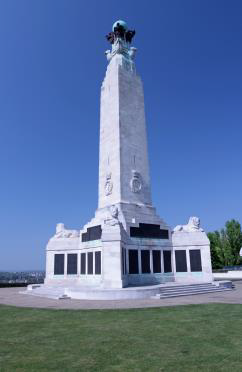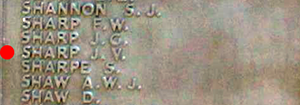Second World War - Lynsted Memorial Project
John Vivian SHARP (of Lynsted)
b.14th February 1920 Able Seaman, Service Number C/JX 148382 Chatham Naval Memorial, Panel 56, column 1 |


John Vivian (Jack) Sharp was born on 14 February 1920. The oldest of the three sons of Harold James William Sharp, a bus conductor, and Elsie Sharp (née Webb). His younger brothers were Eric James, born on 21 March 1927, and Maurice William, born on 16 April 1932.
John's mother died in 1935 and his father married widow Emma Charlotte Reynolds, in 1938. At the time of the 1939 Register Census, the family were living at 3 Vigo Terrace, Lynsted, along with their step-brother Arthur George Hopkins.
Just a few months before his death, John married Dorothy Marion Cheeseman of Canterbury.
At the time of his death John was serving on HMS Arethusa. It had left Alexandria to form a part of the escort for a convoy to Malta that was under siege. On the 18 November, 450 miles from port, she was torpedoed by low flying enemy aircraft, the explosion and resulting fire took the lives of 156 men from the ship's complement of approximately 500. Arethusa was the only casualty of "Operation Stoneage" and the arrival of the four merchant ships of convoy MW-13 effectively marked the end of the siege of Malta.
The ship was badly damaged but managed, after a gallant struggle by her crew, to get back to Alexandria. Experts who examined her later in dry dock stated that it was a miracle she didn't sink.
The official report given by the Admiralty to the next of kin of the dead, read as follows:
On November 18th 1942, HMS Arethusa formed part of the escort of cruisers and destroyers taking an important convoy through the Eastern Mediterranean to Malta.
It was important because Malta needed stores to enable her to fulfil the role allotted to her in the great general offensive operations which had opened with the British Eighth Army's advance from Alamein positions a few days previously. During the day the convoy was passing through that part of the Mediterranean between Cyrenaica and Crete known as "Bomb Alley" and at dusk had reached a position about half way between Derna, on the hump of Cyrenaica, and Malta. Both the convoy and the escorts had been attacked during the day but neither had been damaged.
At the very end of twilight, in that difficult light when visibility favours the aircraft rather than the ship, a strong formation of German Torpedo-Carrying Aircraft made a most determined attack upon the escort.
The Arethusa was attacked simultaneously from both sides and was able to avoid all but one of the torpedoes. This torpedo hit her and caused a violent explosion accompanied by a severe blast. The blast killed instantaneously all the men in the vicinity. Some not quite so close were badly burned by the flash and some of these unfortunately died later of their injuries. The next of kin of these men were informed that their kinsmen had died from burn injury, but it can now be stated with some certainty that all the remainder were killed at once by the tremendous blast and that they would not have suffered pain.
Their bodies were buried at sea, altogether three services were held, and they were taken by the Chaplain very beautifully and reverently.
A memorial service was held ashore later when the ship reached port and it was a most impressive service.
Correspondence is now being exchanged with the Commodore of the Royal Naval Barracks at Chatham about a permanent memorial to these gallant men to be placed in the Barracks Church. It will probably form a part of the general memorial to all the men of the Chatham Division who lose or have lost their lives in this present war.
In the book "The Last Destroyer", the story of HMS Aldenham 1942-1944, first published 1988, the author F A Mason RN DSM - who saw Mediterranean service on Aldenham from 1941-1944, writes about the part his ship played in the burial of the dead of the Arethusa:
The SEA BURIAL
Speculation soon became reality by the announcement in a tannoy broadcast of the task in hand, and what a gruesome thing it was going to be. At 1500 hours we would slip and proceed alongside the damaged cruiser Arethusa, take on board approximately 50 dead bodies, proceed to a point about 3 miles off Alexandria and conduct a sea burial, the time to coincide with sunset.At the appointed time precisely we got underway and proceeded slowly across the harbour to where the Arethusa lay alongside one of the moles. Approaching, we had chance to size up the damage she had sustained, having been hit by a torpedo dropped from an enemy aircraft. 'X' turret was missing completely, and the whole of the front of the bridge was an area of blackened distorted metal, caused by the huge fire after the explosion.
Great gaping holes in her hull for'ard, and was well down at the bows, showing she was partly flooded. But what riveted our attention more then anything was the canvas covered objects lying on the mole, laid out in lines and attached to each one a 4" projectile. The bodies of the Arethusa's men mostly marines - who had perished in that holocaust of an explosion and fire, now sewn up in canvas hammocks, waiting to be carried to their last resting place - the sea, on which they had so gallantly served in the cause of freedom.
Without any fuss we tied up, and a section of the ships guardrails removed on the starboard side against the jetty, and a wide board placed down on to Aldenham's deck and made fast at the other end. Then commenced the job of sliding the bodies carefully down the ramp and stacking them high on deck, some under the boats davits, some against the torpedo tubes, and more aft towards the quarterdeck, leaving the port side clear for the conduction of the service.
The last body brought inboard, the board pulled back, the guardrails replaced, and then two padres came on board followed by a funeral firing party from H.M.S. Orion, and lastly a very young marine bugler.
With a signal from the bridge wires were cast off, and Aldenham slowly moved away, to commence her journey to the open sea. At the same time the cruiser had cleared lower deck, the men standing quietly facing outboard, caps removed in a last farewell gesture to their fallen comrades. Suddenly the peace of the afternoon was shattered by the shrill blast of a boson's call from high up on the cruisers bridge.
The 'still'. Everybody at attention, and not a sound except the Aldenhams screws churning up the water. Then the 'carry on', as the ship turned away crossing the harbour to the open sea, ensign at half mast.
Slowly we cleared the boom and out into the blue calm of the Mediterranean, the sun settling away in the western sky throwing long rays across the placid water.
The ships engines shut down and slowly we came to a standstill, and with that the C. of E. Padre stood up on the torpedo tubes platform and commenced this solemn service for burial at sea, his voice sadly droning on, the ships company gathered around with heads bent, and sea breezes playing little tricks on hair and collars. Then it was the R.C. service.
Emotionally and bravely, the Padre carried on this sad service until at the conclusion he closed his prayer book with a definite movement. This was the cue for the funeral firing party. At a command from their officer they raised their rifles to the firing position. Then one volley, another and another until the end, and with that the order 'present arms'. A pause and the marine bugler sprang to attention, his bugle ready at his lips. Loud and clear across that still blue water - the 'Last Post'. Slowly the notes died away and the one minutes silence. Everybody and everything dead quiet, even the sea breezes and birds seemed to pause in stillness at this very heart rending moment. Then it was over as if a spell had been broken and men who had volunteered commenced their gruesome task of committing the bodies to the deep.
The guardrails were slipped a suitable board positioned, and in pairs the corpses were tilted over the side. Half way through this task some of the bodies were floating having not been sufficiently weighted, and both padres became very agitated, but their fears were soon allayed when P.O. Harvey and another man produced a couple of very long boat hooks, and gently pressed the bodies under until they sank. As the setting sun disappeared below the distant watery horizon, proclaiming the end of another day, so the last body was committed to the deep.
All over, the ships engine room was given the order 'slow ahead' and we turned for Alexandria harbour, a wistful look back at a solitary poppy wreath bobbing lightly on the waves. All that was left to show the resting place of those brave men who had paid the extreme sacrifice.
Somewhere across the sea in our homelands postmen and telegraph boys would be knocking at doors handing in telegrams, "The Admiralty regrets......" . So much for the fight for freedom.
On landing the padres and firing party, the Aldenham returned to her usual billet (another destroyer had taken over E.M.D.) and at 1800 hours the pipe went out "Hands muster for additional rum issue". Quietly the men mustered with their jugs cans, but there was no cheering. They had performed a very unpleasant job, efficiently and dignified, and it had left the ships' company with some very sombre thoughts. Leave was piped for 1900 but no one was interested. All they needed was peace and a long restful undisturbed night.
It is perhaps reassuring that, wherever possible, our casualties were treated with the dignity and reverence they so well deserved.
John is commemorated on the Chatham Naval Memorial, Panel 56, column 1.
In 2001, the Arethusa Association members dedicated a tree to the Arethusa's lost crew at the National Memorial Arboretum at Alrewas.
The Society is indebted to the Arethusa Association and Martin Mitchell for their kind permission to reproduce the information showed here and to reproduce the extract from "The Last Destroyer".

